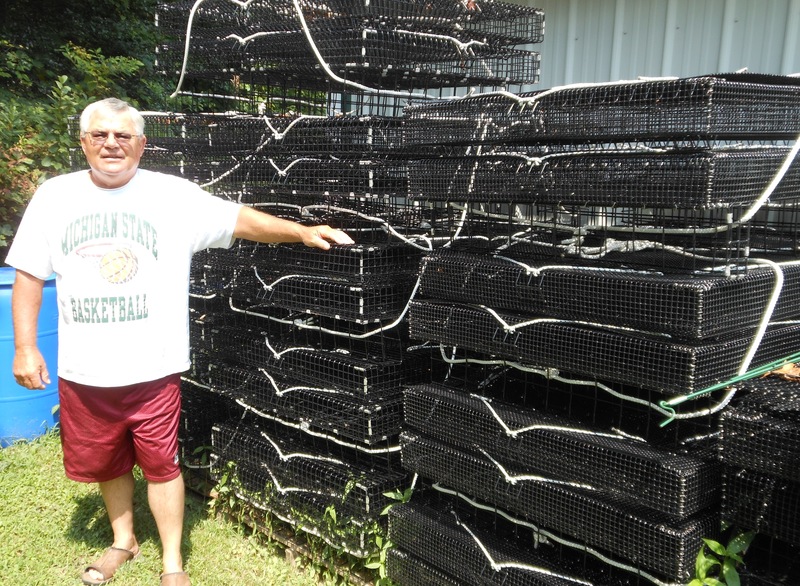DNREC issues shellfish aquaculture regulations

In anticipation of the moment when the state will begin accepting applications for shellfish aquaculture permits, Steve Friend started getting ready. He's began building oyster and clam cages in March.
“I just want to get it going, to get it started,” he said from his home in Georgetown while standing in front of a stack of 30 cages.
It's been a long process, one that took a big step forward recently when the Delaware Department of Natural Resources and Environmental Control announced the final regulations regarding shellfish aquaculture Aug. 1. They went into effect Aug. 11.
Though he is frustrated with how long the process has taken, Friend is happy the regulations are finally ready.
He says DNREC has really dragged its feet on the regulations and there's still a lot of hard work to be done before any oysters or clams are taken.
Friend grew up in Lewes and has been raking clams since he was 10. After retiring from the U.S. Postal Service, he took on clamming full time.
The key to getting the clams, he said, is to tickle them out with the rake, and estimates that on a good day, in four hours he can harvest 1,800 clams.
He said he's looking forward to aquaculture because it will provide people with an opportunity to know where they're working on a day-to-day basis.
The process to create these regulations began after Gov. Jack Markell signed House Bill 160 in August 2013 creating a shellfish aquaculture industry in Delaware. The state was the last on the East Coast to adopt legislation establishing an aquaculture industry.
There were two public workshops early in 2014 in Lewes for individuals looking to get questions answered and provide DNREC with comments. The initial proposed regulations were then published by DNREC May 1; a public hearing was held May 21.
David Saveikis, DNREC Division of Fish and Wildlife director, said he thinks the regulations do a good job balancing different perspectives and he credits the public hearing process.
“We're very pleased, and the public input was critical to that,” he said.
Saveikis stressed aquaculture is not a hobby, and there are significant start-up costs associated with the new industry. He estimated that the first year could range from $15,000 to $30,000.
Friend estimated he's already spent $25,000.
Chris Bason, Center for the Inland Bays executive director, was part of the group that helped the state develop its Shellfish Aquaculture Development Areas or SADAs.
In Rehoboth Bay, 260 acres in three locations have been set aside for aquaculture, representing 4.3 percent of the total bay area. In Indian River Bay, there are 125 acres in two locations, representing 1.36 percent of total bay area. In Little Assawoman Bay, there are 227 acres among four locations that represent 9.3 percent of total bay area.
Bason said the state generally adopted the areas as the team recommended, only slightly modifying some areas. He said overall, the areas have a low density of native hard clams and little recreational boat traffic.
“They're good, not perfect, but they're never perfect,” he said.
Minimum lease acreage is one acre, and the maximum any one applicant can apply for is five acres within Rehoboth and Indian River bays combined. An applicant who leases up to five acres in Rehoboth and/or Indian River bays may also lease an additional one to five acres in Little Assawoman Bay.
Friend said he's going to apply for five acres in Rehoboth and Little Assawoman bays.
The application fee for an aquaculture lease is $300. The annual fee for a lease is $100 an acre for a Delaware resident and $1,000 an acre for a nonresidents.
Initially farmers will be permitted to harvest the Eastern oyster in all three bays and hard clams in Little Assawoman Bay.
Bason said the regulations could be improved when it comes to marking the leased acres. He said the regulations seem a bit excessive and could lead to a negative public reaction. He also said the navigation lanes for boats between acres – 20 feet – isn't wide enough.
Friend said he is concerned that farmers have to get a performance bond of $2,000 per acre leased and liability insurance of at least $1 million.
Saveikis said the next step in the process is getting approval of the SADAs by the U.S. Army Corps of Engineers, but he's expecting that to be a relatively smooth process. He said the areas were created with the Corps regulations in mind.
Saveikis said Corps approval should take a couple months, but he's cautiously optimistic that DNREC will be issuing leases as early as this fall.
There are going to be some growing pains, said Saveikis, but the overall the industry will provide local jobs, local seafood and help clean the bays in the process.
For a full list of the new shellfish aquaculture regulations, go to www.dnrec.delaware.gov.





























































